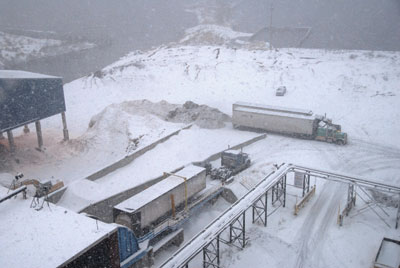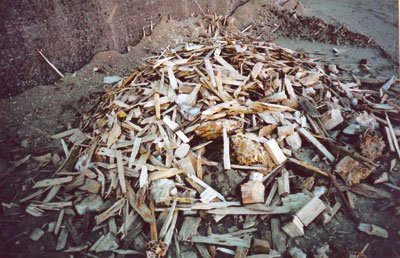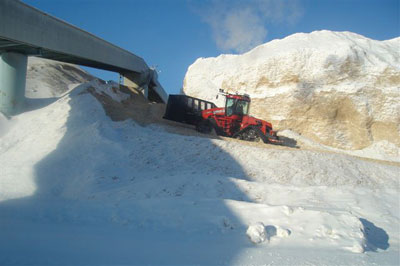
Cold Climate Cures
February 10, 2011
By Paul Janzé
Designing material handling systems for use in extreme northern environments requires special care.
Designing material handling systems for use in extreme northern environments requires special care. Temperatures in northern Canada can vary from –45˚C in winter to +35˚C in summer. In winter, snow load, blowing snow, and ice build-up are always problems to be encountered. And in extreme cold, steel becomes very brittle and susceptible to damage from impacts.
 |
|
| Snow-covered logs wait to be chipped or ground into biomass. Photo: Bill Tice
|
In warmer climates, you can always push the design limits and use short, steep, small, high-speed conveyors. In extreme cold climates, however, simultaneously pushing all design limits is a recipe for disaster. It’s best to be conservative in the design of material handling systems.
Biomass is particularly difficult to handle. It is inherently wet and therefore freezes, it can have ice particles frozen to it, and it may contain loose snow. The particle size of biomass is rarely uniform, and the product tends to knit together and doesn’t flow well, particularly when packed with snow. Frozen wood chips are brittle and readily break up on impact into smaller particles, which is a concern for certain processes. In addition, contaminants such as dirt and grit, which may normally be removed by screening, can freeze and stick to the biomass. These challenges require special consideration but can be addressed. The following is a list of biomass handling remedies and recommendations for cold climates that I have learned over the years.
Loads, slopes, & transitions
Expect that biomass stored in open storage piles will be covered with snow for much of the year. Unless the snow is scraped off, conveyors should be sized to handle the additional amounts of loose snow that will be reclaimed with the product. Also, expect frozen lumps to come off the pile. If there is no scalping screen or lump breaker ahead of the conveyor, design the chutes and skirtboards to handle the largest anticipated frozen lump.

|
|
| In cold climates, frozen biomass, ice, and loose snow can add to the difficulties inherent in handling biomass. . Photo: Bill Tice
|
The load on the conveyor should be kept lower than normal to increase belt-to-product contact, and the speed should be kept fairly slow. This will result in a wider than normal belt.
Transitioning from one conveyor to the next requires special care to give the frozen and slippery product time to reaccelerate. To ease the transfer of material from one conveyor to another, limit the conveyor slope in the loading zone to 6˚ or 7˚. Limit the maximum conveyor slope to 12˚ and avoid across-the-line starting to prevent material slide-back when restarting a loaded belt. I prefer electrical soft-starts, as they are not affected by temperature and are easily adjustable. Additionally, maintenance can be done in warm electrical rooms rather than out in the cold.
If conveyor slopes greater than 12˚ can’t be avoided, consider using grooved belts (negative cleats), which are fine for slopes up to 15˚. For slopes greater than 15˚, use belts with positive, vulcanized multi-cleats. Generous vertical concave curve radii are recommended.
Avoid having a long, outdoor conveyor entering a warm, moist building. Moisture will condense and freeze on the cold conveyor. It is better to have a transfer occur outside the heated building onto the tail end of a warm conveyor that is mostly inside the heated building.
Belts & structures
If slide-back is an issue on existing conveyors, you may choose to use de-icing chemicals, which can be sprayed or dripped onto the belt. De-icing systems are costly and should be installed only as a retrofit.
 |
|
| A scalping screen will remove large frozen lumps of material, as well as outsized pieces of wood. Photo: Paul Janzé
|
Use belts designed for extreme low temperatures, i.e., those that retain their flexibility and won’t crack.
If the conveyor system uses belt weigh scales, plan on recalibrating them at least twice yearly: once in winter and again in summer.
Extraordinary expansion and contraction can be expected with extreme temperature ranges and must be accommodated in the design of conveyors and structures. For example, a 500-foot conveyor will expand and contract approximately six inches with a temperature range of –45˚C to +35˚C. Conveyors and structures must have a sufficient quantity of properly placed expansion joints to accommodate this extreme expansion and contraction.
Avoid high alloy steel shafts. It’s best to stay with large-diameter, low-carbon shafts.
Use lubricants designed for the extreme temperature variation. Under extreme cold temperatures, viscosity should not increase to the point that grease and oils solidify; they must remain fluid. At extreme warm temperatures, lubricants should not thin out to the point at which they are no longer lubricating.
Cleaning & maintenance
Conveyors should be covered to prevent material from blowing off the belt. However, it is recommended that conveyors be carried inside enclosed galleries. At extreme cold temperatures, even a slight breeze can cause frostbite in just a few seconds. If working conditions are poor, equipment will not be maintained.
 |
|
| Biomass that’s stored in the open will contain snow, so conveyors must be able to handle the additional load. Photo: Paul Janzé
|
The bottom of the gallery below the belt should be kept open to permit snow and dust to fall from the return belt. This avoids snow and dust build-up inside the gallery, which is not only hard to remove, but can result in serious structural overload. The amount of snow and dust falling off return idlers can be substantial, so provide lots of space under conveyors for clean-up access.
Access on frozen, snow-covered surfaces can be treacherous. Use stairs and avoid ladders wherever possible. Use safety-grip grating on walkways and platforms. Northern areas have very short winter daylight, so provide good lighting along conveyors.
Avoid using belt brush cleaners; they will immediately fill up with snow and dust. Two sets of carbide-tipped belt scrapers are recommended for scraping frozen snow and dust off the belt. There will be a lot of snow dust coming off the scrapers, so provide a lot of room below the scrapers inside the head chute.
Raised-cleat belts are hard to clean; belt scrapers cannot be used. The only effective way to clean them is to use a properly designed and applied air-knife. Also, consider using a “thumper” roll to shake the frozen snow and dust off the return belt.
Snow and dust will stick to almost any surface; therefore, use steep chute angles and large-radius corners between chute plates. If possible, line chute plates with UHMW PE (ultra-high-molecular-weight polyethylene) or PTFE (polytetrafluoroethylene) plastic, to which ice and snow don’t readily stick.
If dust control is part of the material handling system, the amount of airborne dust to be handled will be many times greater in winter because snow crystals will loosen from the product and be sucked into the dust pick-ups. If possible, avoid baghouses, as they can become clogged with packed snow. High-efficiency cyclones are less prone to plugging.
Other considerations
Avoid heating the equipment or low-occupancy structures to the point at which the product will thaw out. Not only is heating costly, but there is a danger of the material re-freezing. There is a tendency to apply heat to chutework, which is susceptible to freezing. This is not a good thing to do; it will only increase the freezing problem by moving it further downstream. Experience has shown that the worst seasons for conveying moisture-laden materials that will freeze are the spring and fall “shoulder” seasons, when temperatures are +/–5˚C.
Use drive pulleys with large diameters and vulcanized diamond-shaped lagging to increase traction. Snub pulleys are recommended.
Space pre-tensioned safety pull cord switches closer together than normal to minimize the effect of pull cord contraction/expansion causing nuisance trips.
Special care should be taken with the design of fire protection. Dry systems are required. Keep the size of sprinkler zones small, so that if one is activated, there isn’t a huge area to drain before it can freeze. Heat or flame detection is recommended.
When handling biomass, the material density can vary widely depending upon the form of the biomass and the moisture content. Determine the amount of bone-dry fibre needed for the process and use the lowest density for volumetric calculations. For power and strength calculations, use the selected volume but at the highest density. Be sure to allow extra capacity for the handling of loose snow.
All of the above recommendations cannot always be accommodated, particularly those having to do with conveyor geometry. For example, sometimes there is no option but to use conveyors steeper than recommended. Also, many installations are not constructed as I have described, but they work satisfactorily. Every installation is unique, and all conditions should be considered, but if you have the real estate and the budget and you follow these rough guidelines, there will likely be few conveying problems.
Paul Janzé is a senior industrial material handling specialist with more than 30 years of experience in engineering, equipment design and manufacture, project management, and maintenance, primarily in the forest products industry. He is a specialist with difficult-to-handle materials such as wood chips, waste wood, bark, biosolids sludge, wet pulp, poultry litter, animal tissue, and fly ash, which all have unique handling characteristics. Paul can be reached at pjanze@telus.net or through his website at www.advancedbiomass.com .
Print this page